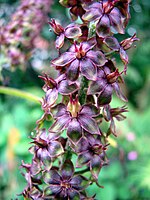Veratrum
| Veratrum | |
|---|---|

| |
| Veratrum album[1] | |
| Scientific classification | |
| Kingdom: | Plantae |
| Clade: | Tracheophytes |
| Clade: | Angiosperms |
| Clade: | Monocots |
| Order: | Liliales |
| Family: | Melanthiaceae |
| Tribe: | Melanthieae |
| Genus: | Veratrum L. 1753 |
| Synonyms[2] | |
| |
Veratrum is a genus of flowering plants in the family Melanthiaceae.[3] It occurs in damp habitats across much of temperate and subarctic Europe, Asia, and North America.[2][4][5][6][7]
Veratrum species are vigorous
-
Veratrum nigrum flowers, Poland
-
Veratrum album subsp. oxysepalum, Fukushima Prefecture, Japan
-
Veratrum viride shoot emerging, Quebec, Canada
-
Veratrum stamineum in the mountains of Japan
Ecology
Veratrum species are used as food plants by the
Habitat

Widely distributed in
Toxicity
Veratrum plants contain highly toxic
The toxic alkaloids are only produced during active growth, and are degraded and metabolized during the winter months. Native Americans harvested their roots for medicinal purposes during their dormant period.
Uses
Medical research
During the 1930s Veratrum extracts were investigated in the treatment of high blood pressure in humans. While initial results were promising, many of the patients suffered side effects due to the narrow therapeutic index of these products. Due to their toxicity and the availability of other less toxic drugs, use of Veratrum as a treatment for high blood pressure in humans was discontinued.[9]
Herbal medicine
Veratrum plants are known both in western herbalism and traditional Chinese medicine as toxic herbs to be used with great caution. It is one of the medicinals (Li lu, 藜蘆) cited in Chinese herbal texts as incompatible with many other common herbs because of its potentiating effects. Especially, many root (and root-shaped) herbs, particularly
The roots of
Species
- Accepted species[2]
- Veratrum albiflorum: Russian Far East
- Veratrum album: Europe, Siberia, Caucasus, Turkey
- Primorye, Korea, Japan
- Veratrum anticleoides: Russian Far East
- Veratrum californicum: western USA; Mexico (Chihuahua, Durango)
- Veratrum dahuricum: Siberia, Russian Far East, Korea, China
- Veratrum dolichopetalum: Russian Far East, Korea, China
- Veratrum fimbriatum: California (Sonoma + Mendocino Cos)
- Veratrum formosanum: Taiwan
- Veratrum grandiflorum: China
- Veratrum hybridum (syn V. latifolium): eastern United States
- Veratrum insolitum: Washington, Oregon, California
- Veratrum lobelianum: Russia, Mongolia, Xinjiang, Central Asia, Caucasus
- Veratrum longibracteatum: Honshu
- Veratrum maackii: Russian Far East, China, Korea, Japan
- Veratrum mengtzeanum: China, Thailand
- Veratrum micranthum: Sichuan, Yunnan
- Veratrum nigrum: Eurasia from France to Korea
- Veratrum oblongum: Sichuan, Hubei, Jiangxi
- Appalachiansin eastern USA
- Veratrum schindleri: China
- Veratrum shanense: China, Myanmar
- Veratrum stamineum: Japan
- Veratrum taliense: Sichuan, Yunnan
- Veratrum × tonussii : Italy
- Veratrum versicolor: Korea, China
- Veratrum virginicum: central and eastern United States
- Veratrum viride: northeastern and northwestern North America (but not central)
- Veratrum woodii: south-central United States
See also
References
- ^ 1897 illustration from Franz Eugen Köhler, Köhler's Medizinal-Pflanzen
- ^ a b c Kew World Checklist of Selected Plant Families
- ^ Tropicos, Veratrum L.
- ^ Flora of North America, Vol. 26 Page 72, False hellebore, skunk-cabbage, corn-lily, vérâtre, varaire, Veratrum Linnaeus, Sp. Pl. 2: 1044. 1753; Gen. Pl. ed. 5: 468. 1754.
- ^ Flora of China Vol. 24 Page 82 藜芦属 li lu shu Veratrum Linnaeus, Sp. Pl. 2: 1044. 1753.
- ^ Altervista Flora Italiana, genere Veratrum includes photos and European distribution maps
- ^ Biota of North America Program 2013 county distribution maps
- ISBN 978-1405332965.
- ^ S2CID 42124743.
- ^ "Teratology Society". [dead link]
- ^ ISBN 0-87842-359-1
- ^ a b c Bensky, D., Clavey, S., Stoger, E. (2004). Materia Medica (3rd edition). Seattle: Eastland Press. p. 461.




